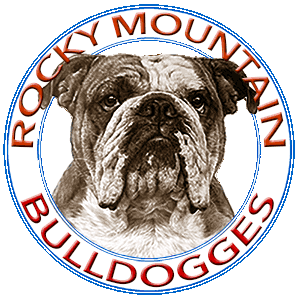Temperament and Character
The Olde English Bulldogge is a "thinking" breed. Their intelligence is readily demonstrated by their problem solving ability and their adaptability. They are extremely sensitive dogs who bond closely with their owners and family. The Olde English Bulldogge is generally kind and peaceful with its family and friends, often extending the family circle to include other household pets as well as people. Many of these dogs have been raised with cats and it is not unusual to see them playing together around the house or in the yard, or to see cats in the kennel. Olde English Bulldogges can be territorial and should be introduced to other dogs with care. Again, many of these dogs have been raised with other dogs and carefully supervised. There is a certain degree of same-sex aggression, but training and careful supervision may help to overcome this behavior. Neutering of non- breeding animals is highly recommended after the dogs first year. In most cases, it will reduce tensions and aggression. In general, Olde English Bulldogges are highly social animals who enjoy good company in any form.
The Olde English Bulldogge is generally very accepting of strangers. In fact, they can be very outgoing and friendly. However, their friendliness is the result of their profound intelligence and their absolute confidence. In other words, while they might appear gentle and friendly, they are not indiscriminately submissive. Olde English Bulldogges are, above all, "thinking dogs" that can and will form their own perspectives of people, their environment, and situations.
Although the Olde English Bulldogge is instinctively protective, some dogs mature slowly and may not exhibit this trait until around 1 ½ to 2 years of age. The OEB is very receptive to many types of training, provided the individual Bulldogge selected for such work is outgoing, stable, confident, and the training methods employed are positive. A Bulldogge lacking confidence or harshly trained will not be reliable under pressure or capable of good judgment in all situations.
Olde English Bulldogges are generally very willing to please their owners and learn readily as a result. They can however, be stubborn about simple things like going into their kennel for the day when they would prefer to be taken along in the car. They are, after all, "thinking dogs" and they sometimes exercise this intelligence at inconvenient times. Their intelligence, sensitivity, and desire to please, combine to make them very trainable dogs. But all training should be undertaken from a positive and motivational perspective. The Olde English Bulldogge does not respond well to harsh correction or compulsion and such measures will not bring about reliable results.
The bull breeds are generally excellent with children and the OEB is no exception. They are often at their very best with children, as their intelligence, sensitivity, desire to please, and astonishing capacity for play make them excellent companions for children. Their natural protectiveness is also an asset for a family pet. As with ANY dog, young children should be supervised when playing with an Olde English Bulldogge, while the dogs are acutely aware of their size and strength, these powerful animals can easily frighten a small child if the game gets too lively. Most often, the dogs demonstrate a natural ability to adapt their games to the child's size and strength. Fetching games and play involving simple obedience commands given by the child are excellent ways to build a rapport between child and dog.
HISTORY of the Olde English Bulldogge
Bulldogs were created for the English sport of bull baiting, practiced from approximately 1100 until 1835. By the middle of the 1800’s, the sport was no longer legal, and the athletic bulldog quickly began to disappear. Because the bulldog was revived solely for the conformation venue, selective breeding for appearance severely compromised the health and lifespan of this once agile, athletic and happy breed.
In 1971 David Leavitt started his project of breeding back to a dog with the appearance of the Regency period Bulldog. He named the breed Olde English Bulldogge (OEB) to clearly differentiate it from the modern EnglishBulldog. Mr. Leavitt used a line breeding scheme developed by Dr. Fechimer of Ohio State, to rapidly achieve a pure bred dog. Since the 1970’s many people have used the Olde English Bulldogge name for dogs that are not related to the original lines. Multiple registries service these OEB breeders. There is a huge range in appearance and health in these OEBs. The original Leavitt Olde English Bulldogge blood lines are a small percentage of the thousands of present OEBs.
Today’s Olde English Bulldogge matches the looks of the bull baiting dog of the early 1800’s. They are, first and foremost, excellent companions, while also possessing the drive, temperament and agility to perform in numerous working venues as well as being service dogs. The revival of a healthy dog with the longevity to live well into its teens is a primary goal.
Our Olde English Bulldogges are recognized by the United Kennel Club on January 1, 2014.

